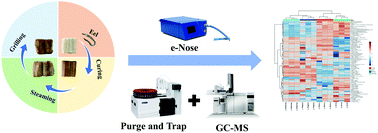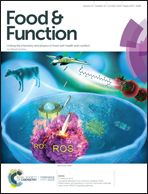Formation and conversion of characteristic volatile compounds in grilled eel (Astroconger myriaster) during different processing steps†
Abstract
The aroma of grilled eel is affected by three key processing steps: curing, steaming, and grilling. This study was aimed at the determination of the difference between the characteristic volatiles in each processing stage and their influence on the final aroma of grilled eel. A total of 92 volatile compounds were identified by purge and trap (P&T) combined with gas chromatography-mass spectrometry (GC-MS) throughout the processing. Alcohol, ketone, aromatic compounds and methylated compounds were the most important volatiles in the eel meat during processing. Pyrazine was generated gradually during the entire process, and 2,3-dimethylpyrazine was only found in the sample after grilling. Distinct odors among the raw and treated samples could be indirectly distinguished according to their volatile compounds, analyzed by heatmap. Together, these results indicate a relationship between the final aroma and the whole processing. The odor coding made from the odor activity value (OAV) could be as a reference benchmark for the grilled eel product.



 Please wait while we load your content...
Please wait while we load your content...